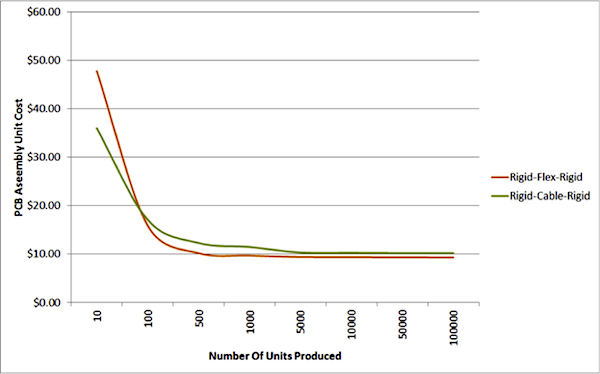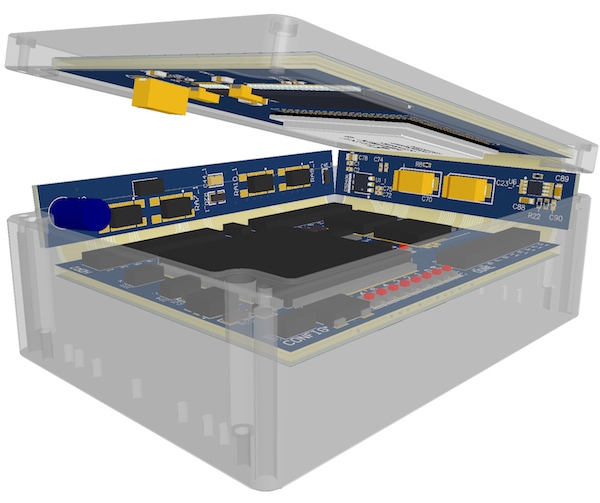The case for rigid-flex PCB technology
When to use flex
It’s getting harder to fit everything in the box; it’s also getting more costly. One solution promising to help designers meet the size constraint head on is rigid-flex PCB technology, but most design teams try to avoid using rigid-flex PCBs when product cost is an issue. But is it really as expensive as we think?
To begin with, consider the cost of the traditional rigid-cable-rigid PCB assembly to one based on rigid-flex technology. The former construction works well for short-run designs; however, it requires connectors on each board and the interconect, all of which drive up BoM cost. Additionally, the rigid-cable-rigid design is prone to ‘cold joints’, and reduced service life. In contrast, rigid-flex circuits eliminate these joints, making them much more reliable and able to deliver overall higher product quality and longevity. So while rigid-flex PCB technology is certainly not new, various considerations now make it much more viable – not the least of which is cost.
Simulate the cost
In some designs, rigid-flex will not be a viable alternative, and you must do your due diligence in determining the break-even point WHERE the costs are about equal. This kind of price simulation can be done by considering the total quoted costs for fabrication and assembly. The PCBs can be quoted before design, as long as the parameters of design are well understood (for example, the layer stack, estimated via count, track and space ratios, etc.).
We performed a manufacturing cost simulation with a real rigid-flex design and a comparative rigid-cable-rigid equivalent. The component BOMs for comparison differed only in the cable and connectors required for the non-flex version. For our simulation, the traditional design is comprised of four-layer boards that use flexible cable and connectors between them, while the rigid-flex design is a four-layer PCB with two inner flex layers. Manufacturing cost for both designs is based on real PCB fabricator quotes, and includes the cost of assembly.

Figure 1 This quote-generated cost plot compares a rigid-flex design to a rigid-cable-rigid assembly.
Find your break-even point
As the project volume depicted in Figure 1 hits 100 units, the rigid-flex design becomes a more cost-effective option compared to the traditional design approach. A key reason for this cost savings is that rigid-flex circuits do not use connectors/cables or require any connector assembly. Also, they feature increased reliability and process yields. But that’s just the tip of the iceberg.
Because rigid-flex PCBs require no cable assembly, their overall assembly effort is reduced, as is their test complexity – both of which drive down cost. Additionally, fewer components need to be purchased, reducing the supply chain risk. Rigid-flex PCBs can be designed to make product maintenance more convenient and therefore, more cost-effective over the course of the product lifecycle.

Figure 2 Rigid-Flex visualization of a field-serviceable assembly
What about design time?
While the cost of manufacturing, assembly, testing, and logistics are key factors in considering the viability of rigid-flex technology for any given project, design and development costs cannot be overlooked. Rigid-flex design often requires the mechanical team to assist with the flex portion of the design, and PCB integration with the final product. The process is very time consuming and costly, as well as prone to errors.
Making matters worse, PCB design tools often ignore the folding and fitting aspects of rigid-flex design. Rigid-flex technology design requires designers to think and work in 3D. The flex portions can be folded, twisted and rolled to follow the design of the mechanism. But traditional PCB design tools don’t support 3D board design or the definition and simulation of bends and folds in the flex portion of the design. They don’t even support the definition of different layer stacks in different parts of the design, including the areas comprising the design’s flex part.
Because of this, rigid-flex designers have been forced to manually translate both the rigid and flex sections of their 3D design into a flat, 2D representation suitable for fabrication. Then they have to manually document all areas of the design that are flex, and double check that no components or vias have been placed near the transitions between the design’s rigid and flex portions. This process is governed by many additional rules, most of which are, not too surprisingly, not supported by most PCB design software.
In general, the extra effort it has taken to design rigid-flex PCBs as compared to standard rigid PCBs using traditional PCB design software has made them much less cost competitive. Luckily, modern design tools with advanced 3D capabilities, and support for the definition and simulation of bends and folds in the flex portion of the design, as well as the definition of different layer stacks in different parts of the design, are now available. These tools generally eliminate the need to handle the flex part of the design with mechanical CAD tools, saving designers and design teams both time and money.
Design in 3D to ensure success
Early coordination between the developers and the circuit board producer, supported by the use of a modern PCB design tool, is another factor making rigid-flex technology a more cost-effective option. Rigid-flex designs require closer collaboration between the designer and fabricator than traditional rigid board designs. The tradeoffs required to produce a successful rigid-flex design translate to a set of design rules the designer can develop with the fabricator’s input. These considerations include the number of layers in the design, materials selections, recommended sizes for traces and vias, adhesion methods, and dimensional control. With the right design tool, these considerations can be clearly defined and given the proper weight they deserve early on so that the rigid-flex PCB can be properly optimized, further optimizing its overall cost as well.

Figure 3 The PCB CAD tools need to generate a 3D model of the assembly to ensure right-first-time design.
There’s no denying that existing industry trends and consumer demands are pushing designers and design teams to their limits, forcing them to seek new alternatives to the electronic design challenges they now face. These challenges, and especially the requirements being placed on today’s mobile devices, are pushing rigid-flex technology into the mainstream, and making it much more commercially viable for a range of applications. The availability of modern PCB design tools that support 3D product development, early collaboration, and all necessary rigid-flex definitions and simulation greatly minimize the pain of rigid-flex design and make it an even more compelling solution – one that under the right circumstances is cheaper than rigid-cable-rigid PCB design. For today’s design teams, that choice may just mean the difference between product success or failure.
Capacités
Capacité PCB rigide
Capacité PCB flexible
Capacité d'assemblage PCB
Équipement PCB
Équipement d'assemblage PCB
Méthodes de paiement
Prix spéciaux
Transporteurs
Support pour amateurs
Certificat
Assistance clientèle
Suivez-nous
Tel: 1-905-339-2881
Email: [email protected] , [email protected]
Copyright Gold Phoenix PCB Co., Ltd. 2011 - 2023
Tel: 1-905-339-2881 Email: [email protected] , [email protected]
Système de contrôle qualité | Service produit
| Liens
Copyright Gold Phoenix PCB Co., Ltd. 2011 - 2023


